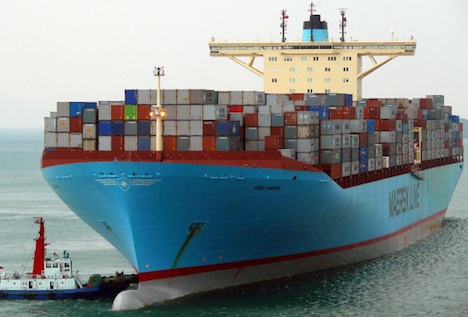
Speed of a container ship is relatively the same as other huge cargo carriers and the speeds could very from 10 to 25 knots depending on weather and cargo delivery deadlines. The term knots in used to measure the speed of vessel travelling on water but it is possible to calculate the speed of the vessel in terms of miles of kilometers per hour to give the common man the average speed the vessel may be travelling at.
There is no fixed speed a vessel must travel at and the speed could be adjusted according to the requirement. The speed is not controlled out at sea but as the vessel approach port or harbors the vessel must be slowed considerably and maintain a safe speed during the approach. During this time the engines as turned to dead slow and tug boats move in and guide the vessel in to port to avoid it from causing an uncontrollable accident.
The vessels must be guided also during the departure but once out of the port area that can rev up their engines and cruise at speed ranging from 10 to 28 knots caring a full load. The knot measure used on marine vessel accounts to 1.852 kph or 1.150mph, in this prospective the numbers can easily be converted to bring in to aspect the speed a vessel could be travelling at. The top speed of a container ship can be estimated at 25knots meaning 25 × 1.852kph or 1.150mph would result on a top speed on land of approximately 46.3 kph or 28.75mph.

The speed of a container ship may sound very slow when compared to land speeds but when one considers that marine vessel do not have any form of emergency breaking system that may stop the vessel suddenly it seems to be a logical speed to travel at and avoid cause major concern and danger if something war to happen suddenly. Steering also becomes a major problem at these speeds since the vessel leans hard if suddenly turned and this could result in loss of containers as the vessel leans as it turns suddenly.
The speed of a container ship or other big cargo ships mainly maintain the safety speeds that are recommended to avoid problems that could result from over speeding plus there are other advantages links to maintain average speeds while sailing. If the vessel maintains an average speed it would mean the vessel would consume less fuel since the engines are run at lower revolutions and are at less strain but when the vessel engine it run at high speed it consume more fuel. Another major factor of maintain average speeds is that incase of a problem the procedure to slow the vessel and if possible turn the engine to reverse may be a little simpler. At full throttle the procedure becomes almost impossible and there may be no way of stopping or averting disaster.
For these reason most cargo vessel have a averagely fixed speed of a container ship but smaller vessel or specialized vessel like the ones used by the coast guard or navy have different speed capability that may surpass the cargo vessel limitations but with no assurance of safety for the vessel.





